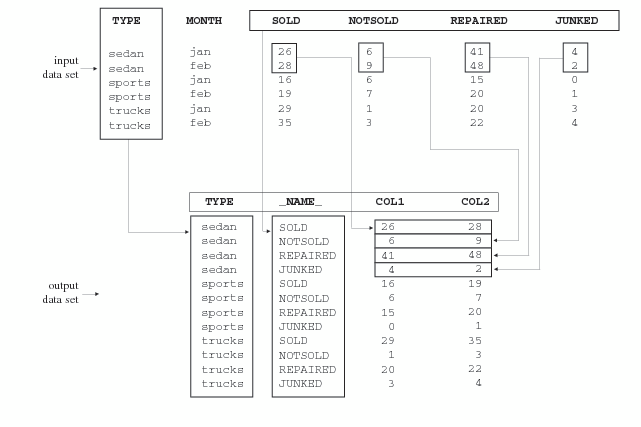TRANSPOSE Procedure
BY Statement
Defines BY groups.
| Restriction: | Do not use PROC TRANSPOSE with a BY statement or an ID statement if another user is updating the data set at the same time. |
| Example: | Transposing BY Groups |
Syntax
Required Argument
- variable
-
specifies the variable that PROC TRANSPOSE uses to form BY groups. You can specify more than one variable. If you do not use the NOTSORTED option in the BY statement, then either the observations must be sorted by all the variables that you specify, or they must be indexed appropriately. Variables in a BY statement are called BY variables.
Optional Arguments
- DESCENDING
-
specifies that the data set is sorted in descending order by the variable that immediately follows the word DESCENDING in the BY statement.
- NOTSORTED
-
specifies that observations are not necessarily sorted in alphabetic or numeric order. The data is grouped in another way, such as chronological order.The requirement for ordering or indexing observations according to the values of BY variables is suspended for BY-group processing when you use the NOTSORTED option. The procedure does not use an index if you specify NOTSORTED. The procedure defines a BY group as a set of contiguous observations that have the same values for all BY variables. If observations with the same values for the BY variables are not contiguous, then the procedure treats each contiguous set as a separate BY group.The NOBYSORTED system option disables observation sequence checking system-wide and applies to all procedures and BY statements. See the BYSORTED System Option in SAS System Options: Reference.
Details
PROC TRANSPOSE does not transpose BY groups. Instead,
for each BY group, PROC TRANSPOSE creates one observation for each
variable that it transposes.
The following figure
shows what happens when you transpose a data set with BY groups. TYPE
is the BY variable, and SOLD, NOTSOLD, REPAIRED, and JUNKED are the
variables to transpose.

